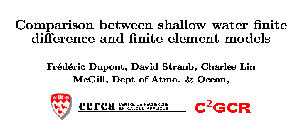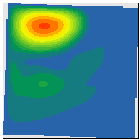
period below 17 days
Max = 7 m

period between 17 and 200 days
Max = 50 m

period above 200 days
Max = 60 m
Click here for Source codes of various models!
In the last decades, we came to the idea that the ocean is a very important component of the climate.
The ocean transports as much heat as the atmosphere but on a shallower depth
and at a slower speed. Climate variability on very long scale (up to thousands of years) is thought to be
related to the ocean variability.
When we don't have enough data from observations we need to rely on computer models
of the ocean. But we need to be confident in them. This means validations with
analytical solutions or existing observations.
Intercomparisons of models is also important to detect flaws.
The goals of this thesis are the followings:
We want to investigate in details the accuracy of finite difference and finite element methods in presence of complex coastline. Then, we introduce a new numerical method, namely, the discontinuous spectral element method and we show applications for flows interacting with complex geometries.
Or in HTML.
RMS of the variability in elevation below 17 days, betwenn 17 and 200 days and above 200 days.
 period below 17 days Max = 7 m |
 period between 17 and 200 days Max = 50 m |
 period above 200 days Max = 60 m |
| Slides for a conference in Halifax, october 2000. |
 |
| First results and comparisons for a Spectral Element model. |

|
| See the presentation for CMOS 1999. It shows the comparison of solutions obtained by Finite Difference and Finite Element models. |

|
| See the Poster presented for the WOCE and CMOS conference 1998. This ones was an investigation of the role of steps along coastlines in Finite Difference models. |

|
| Short study with a 1D Mixed Layer model |

|